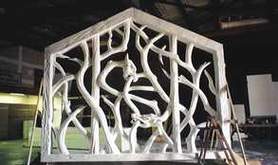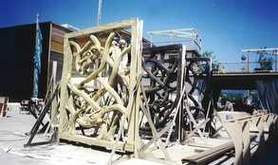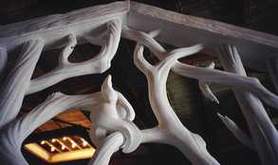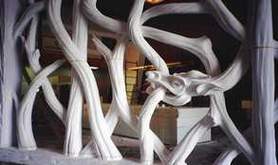| |
The 13th Warrior
Disney/ Elk Bay Productions
It took an army of
Artists & Technicians working in shops, studios, garages, shipyards
and in the bush five months of
continuous labour to get this film made. I think at the time it
broke all records in Vancouver for the largest picture ever made
(maybe in Canada).. The major set, the Viking longhouse erected
on Vancouver Island was 30 minutes by float plane from Vancouver.
The main structure was built from timber collected from all over
Vancouver Island. It was immense. The 'big house' was built on a
hill and a village built around it. There were at least 60 buildings,
roads and even a lake.
 |
 |
Wolfe Kruger, the production
designer was a tough taskmaster, but a great designer. His designs
called for a huge building with gable end windows like a gothic
cathedral. The windows were to be like the woven branches of mythical
Celtic knotwork, made to look as though it had been espaliered into
the shape of the window openings. We made 9 of these window knotworks
with one 20' long and 16' high. At the end above the kings throne.
It was a very fun project. Wolfe was happy with them... or so I
heard.
 |
 |
The 13th Warrior, based
on Michael Critons novel 'The Eaters of the Dead' is set in an imaginary
northern Scandinavia among forests, rain mountains & caves.
The stories climax takes place underground in a labyrinth of caves
with rivers and waterfalls. After months on Vancouver Island dealing
with the longhouse we tackled the cavernous lair of the evil Wendol
Queen. To create this huge set with its 50' waterfall, lake, passageways
& bridges, it required that the surface treatment of the cave,
the actual rock itself be quite realistic. To create this look I
took mould impressions from exposed rock surfaces at Elk Falls on
Vancouver Island.
It was here, at Elk
Falls, that the Wendol bone huts were built with the 100 or so bear
skulls that I had sculpted and cast for the set decoration department.
Once moulds of the rocks were taken (the 4 moulds were of silicon
rubber 10'x10') they were shipped back to Vancouver where polystyrene
rigid foam was sprayed into the moulds making a rock textured panel
which were assembled piece by piece over a light superstructure
to give the cavern its rocky surface.
|
